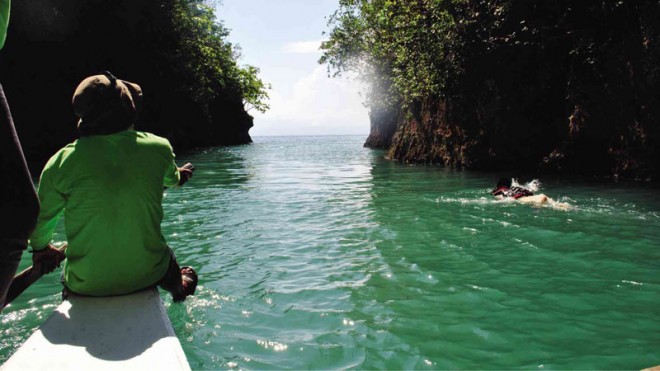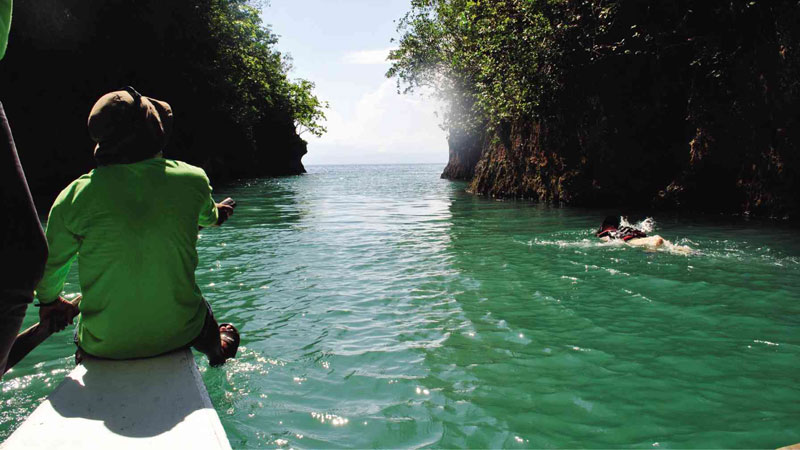
The Inquirer is running a series of articles on the country’s tourism crown jewels—somehow uncut but equally sparkling and surprising as the usual vacation haunts. The articles will appear three times a week during the summer months. Please send us your own hot go-to discoveries to summer by. Text 0917-8177586 for details.—Ed.
ALOGUINSAN, Cebu—Where the river meets the sea in Barangay (village) Bojo here lies a grand underwater theater, where the main stars are colorful clumps of corals teeming with tropical fish.
The 1.3-kilometer Bojo River, fed by 100 springs, is home to 22 species of mangroves and 61 of the 71 bird species found in Aloguinsan, which is 72 km southwest of Cebu City.
The place is a showcase of sustainable community-based ecotourism, arguably the only working model in Cebu, according to Boboi Costas of Grassroots Travel, an ecotourism development consultant of the municipality.
Thanks to the Bojo Aloguinsan Ecotourism Association (Baeta), which runs the tour of the Bajo River, even fishermen like Jerry Bansiloy, who never reached college, can easily recite the scientific names of the mangrove species in the area.
“Those are pagatpat, scientific name Sonneratia alba,” he told a group of tourists on his paddle boat as they cruised down the river two kilometers from the town proper.
Dynamite fishing
Bansiloy and other Baeta members have undergone training on the rudiments of mangrove taxonomy and bird calls from wildlife experts.
The river was not this healthy before, Basiloy said, adding that some fishermen used to go dynamite fishing while residents would cut the mangroves for firewood.
Today, fishermen, who have become Baeta members, work as river cruise guides, pointing out surrounding flora and fauna to tourists, while explaining the significance of local landmarks and the history of the place. The tour boat slides smoothly on emerald-green waters as mangroves gracefully fan the air that has come alive with the chirping of birds.
At the mouth of the river (locally called baba sa suba) towering karsts or limestone formations form a gateway leading to Tañon Strait. Here, as the river opens out to sea, the water turns brackish—its color changing from light emerald green to opal blue—and offers an irresistible invitation to snorkelers, who are guided by fishermen-members of the Aloguinsan Reef Rangers Association.
As riverbed becomes sea floor, a carpet of corals blooms in the shape of palm leaves, ruffled petticoats, bristles and elephant ears, in brilliant colors of red, brown, green, blue, gray and white, according to tourist Jeremi Panganiban, who came with her two sisters and officemates from the Manila-based nongovernment group, Women’s Legal and Human Rights Bureau.
Schools of neon-blue damsel fish, angelfish, parrot fish and butterfly fish can also be seen darting in and out of the coral’s crevices, she added.
Protected seascape
The river, which reaches a depth of eight meters at high tide, is an estuarine of Tañon Strait, a protected seascape that separates Cebu and Negros islands. The strait is a known natural habitat for at least nine marine mammal species—the highest concentration of such species in the country.
Silence reigns underwater, broken only by the gasps of divers when they reach the “drop” and feel like they’re falling into an eerie black hole. But at the turnaround toward the resuscitated coral field, the 360-degree visual delight resumes, along with the feeling of safety.
Tourists who’d rather keep dry can also appreciate the mystic of Bojo River on a bamboo boardwalk 400 meters long and cutting across the mangrove forest, that leads to the hillside where a wooden gazebo offers a panoramic view of the river.
At P969 per head, the Bojo River Cruise includes paddling down the river with fishermen as guides, the boardwalk tour, a riverside buffet lunch prepared by the Cultural Heritage of Aloguinsan Tourism, snacks and an introduction to snorkeling.
The package ends with snacks of salvaro (native bread with coconut baked in a tin can oven), puto (steamed rice cake), budbud (rice cake wrapped in banana leaves), artisan bread and sikwati (native hot chocolate) at The Farmhouse, also in Aloguinsan.
Seafood buffet
Lunch is a buffet of seafood, native chicken, vegetable dishes and fruits.
“[The river cruise] is a showcase of what strong partnerships between local governments and communities can do for a town and its economy,” said Costas.
In September 2008, Costas proposed a community-based ecotourism program around Bojo River that the municipal government, inspired by the presence of tourists who came to town through Suroy-Suroy Sugbo, immediately supported as it would benefit both fishermen and the environment.
Community-based
The local officials also realized that revenues from ecotourism would be a strong incentive to involve the community in environment protection.
At least 50 fishermen and their wives in Barangay Bojo formed Baeta and took charge of the tour.
A year after its launching, the Bojo River tour drew more than 1,000 visitors with gross receipts of P500,000. The number increased to 40,000 after four years and P11 million in gross receipts. The organizers remitted to the town P1.1 million in users’ fees, which the local government collects to fund other environment projects, like sea patrols.
Fourth class
The tour has put Aloguinsan on the tourism map and has vastly improved the economy of this fourth-class municipality whose annual income is between P25 million and P35 million.
His job as a tour guide means extra income, said Bansiloy. “There are times when we cannot go out to sea and fish. It helps that we also earn from ecotours.”
Jomelyn Manigos, Baetas vice president, said that 90 percent of the income from the tour package is given back to the residents, while 10 percent goes to the municipal government.
There is also a sense of pride among the locals, a sense of ownership over the project that is fully funded by the local government.
“Even if we didn’t invest a single peso, we put in more than monetary investment. We invest time and effort, so we can still say that this is our project,” Manigos, a teacher, said.
Ecotourism
The tour has also made people more conscious about the environment and watchful of those who degrade it. Since the tour was launched, several bird poachers have been apprehended while illegal fish traps have been demolished.
Thanks to the added income and the positive impact on the environment, other community-based associations in nearby barangays have followed suit with similar ecotourism projects.
There’s the Fishermen Village Tour (P775) run by Kantabogon Ecotourism Association, which brings guests to a fishing village in Hermit’s Cove in nearby Barangay Kantabogon. Guests are taught how to fish and how to make flour from buri palm. The package includes an introductory snorkeling session and snacks at The Farmhouse.
Meanwhile, a group of women farmers have formed the Cultural Heritage for Aloguinsan Tourism in Barangay Poblacion and now runs a culinary tour for P700 a head at The Farmhouse. Tourists are taught how to grow vegetables and raise livestock organically, and are treated to a healthy lunch, snacks at The Farmhouse and an introduction to snorkeling.
Odyssea Tour
Those who love the sea can take the Odyssea Tour (P999), operated by the Aloguinsan Reef Rangers Association whose members are also trained in water search and rescue operations. The tour includes snorkeling and a sea cruise, a beach boodle lunch, snacks and interaction with the fishermen guides.
Proper attire for drivers
The latest to be organized, Costas said, were the motorcycle drivers who are now accredited and given identification cards by the municipal government. They must also undergo an orientation seminar on body hygiene, proper attire, customer service, Aloguinsan tourism and history.
Thanks to the river that meets the sea in Barangay Bojo, Aloguinsan has surfaced from anonymity to become an ecotourism site.
GETTING THERE
From Cebu City, tourists can reach Aloguinsan town in two hours via a van that can accommodate 12 passengers and can be rented for P5,000.
Or, they can take a bus at the Cebu South Bus Terminal, for P80. But the last bus to Cebu City leaves at 11 a.m., and there is hardly any overnight accommodation at Aloguinsan.
An indirect route is to travel by bus to Toledo City (P70) and then take a jeepney ride to Aloguinsan (P35). A City Link van ride to Toledo costs P100 per passenger.
RELATED STORIES
Masinloc offers access to unique ecotourism sites
Paradise found on islands of giants









































